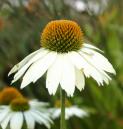Related entry: Coscinium - Tinospora
Calumba root (Calumba, U.S.P.) consists of the dried transverse slices of the root of Jateorhiza Columba, Miers (N.O. Menispermaceae), a climbing plant indigenous to Portuguese East Africa, and growing freely in forests near the Zambesi. The roots are dug up during the dry season, cut into transverse slices, and dried. The somewhat dull colour of the drug as imported is often brightened by a process of cleaning. Calumba root occurs in commerce in flattish discs, varying from 2.5 to 5 centimetres in diameter, and from 3 to 12 millimetres in thickness. They are usually depressed in the centre on both sides, due to contraction on drying, and are of a more or less distinct yellow colour, the exterior being covered with thin, dark brown, wrinkled cork. The parenchymatous tissue of both wood and bark is largely developed, and contains abundant starch. The fracture is short and starchy; the odour slight, and the taste bitter. The drug often contains portions of the rhizome from which the roots spring; these may be recognised by their smaller size (about 2 centimetres in diameter), narrow cortex, and conspicuously radiate wood, with strongly developed lignified tissue, in consequence of which the centre of the slices is prominent instead of being depressed. A transverse section of calumba root exhibits, under the microscope, a cork consisting of a few rows of narrow brown cells, a wide cortex, a bast ring containing narrow bast rays devoid of fibres, and a wood composed of abundant parenchymatous tissue, in which radially elongated groups of pitted vessels are scattered. Near the cork sclerenchymatous cells occur, containing prismatic crystals of calcium oxalate in their cavities. The starch grains with which the parenchymatous cells of both cortex and wood are filled are mostly simple and of large size (20μ to 70μ); they are irregularly ovoid in shape, and exhibit a distinct radiate or cleft hilum. Powdered calumba is characterised particularly by the sclerenchymatous cells with calcium oxalate, the starch grains, and the yellow colour of the sclerenchymatous elements. The following drugs have been substituted for, or used to adulterate, calumba root:—
- Slices of the stem of Coscinium fenestratum; Colebr. (N.O. Menispermaceae), Ceylon; these are dark yellow in colour, hard and woody; not starchy or depressed in the centre.
- Slices of the root of Frasera caroliniensis, Walter (N.O. Gentianeae), North America; these are smaller, thicker, and contain tannin, but no starch.
Constituents.—The chief constituents of calumba root are columbamine, palmatine, and jateorhizine, three yellow crystalline alkaloids, closely allied to berberine; the drug also contains a colourless, crystalline principle, columbin, which yields yellow amorphous columbic acid on treatment with acid or alkali. Another colourless, crystalline principle has not yet been examined. All these constituents contribute to the bitter taste of the drug. A fluorescent principle is also present, as well as an abundance of starch and some mucilage. Tannin is not a normal constituent of the drug. The root yields from 4 to 7 per cent. of ash, but pieces of rhizome may yield from 12 to 17 per cent.
Action and Uses.—Calumba is a pure bitter, and is used in atonic dyspepsia. and debility of the digestive organs (see under Gentian); its preparations possess the advantage of being compatible with salts of iron. Powdered calumba root and extract of calumba are administered in pills, the former also in cachets with rhubarb and soda. Infusion and tincture of calumba are common constituents of bitter acid or alkaline tonics.
Dose.—½ to 2 grammes (8 to 30 grains).
PREPARATIONS.
- Extractum Calumbae, B.P., 1885.—EXTRACT OF CALUMBA.
- Calumba root, cut small, 1 pound; proof spirit, 4 pints. The drug is macerated with 2 pints of the spirit for twelve hours, strained and pressed; the operation is repeated with the marc, using the same quantity of spirit. The liquids are mixed and filtered, the spirit recovered by distillation, and the residue evaporated on a water-bath to a soft extract. Dose.—1 to 5 decigrams (2 to 8 grains).
- Fluidextractum Calumbae, U.S.P.—FLUIDEXTRACT OF CALUMBA.
- Calumba, in No. 20 powder, 100; a mixture of alcohol (95 per cent.), 7, and water, 3, a sufficient quantity to exhaust the calumba. The final product measures 100. Average Dose.—2 mils (30 minims).
- Infusum Calumbae, B.P.—INFUSION OF CALUMBA.
- Calumba root, thinly sliced, 5; distilled water, cold, 100. Dose.—15 to 30 mils (½ to 1 fluid ounce).
- Infusum Calumbae Concentratum, B.P.C.—CONCENTRATED INFUSION OF CALUMBA.
- A product closely resembling infusion of calumba is obtained by diluting 1 part of this preparation with 7 parts of distilled water. Dose.—2 to 4 mils (½ to 1 fluid drachm).
- Liquor Calumbae Concentratus, B.P.—CONCENTRATED SOLUTION OF CALUMBA.
- Calumba root, in No. 5 powder, 50; alcohol, 22.5; distilled water, to 100. This preparation is made by a process of double maceration. Infusum Calumbae Concentratum is a more satisfactory preparation. Dose.—2 to 4 mils (½ to 1 fluid drachm).
- Tinctura Calumbae, B.P.—TINCTURE OF CALUMBA.
- Calumba root, in No. 20 powder, 10; alcohol (60 per cent.), 100. Dose.—2 to 4 mils (½ to 1 fluid drachm).
- Tinctura Calumbae, U.S.P.—TINCTURE OF CALUMBA, U.S.P.
- Calumba, in No. 20 powder, 20; alcohol (57 per cent.), sufficient to produce 100. Average dose.—4 mils (1 fluid drachm).

